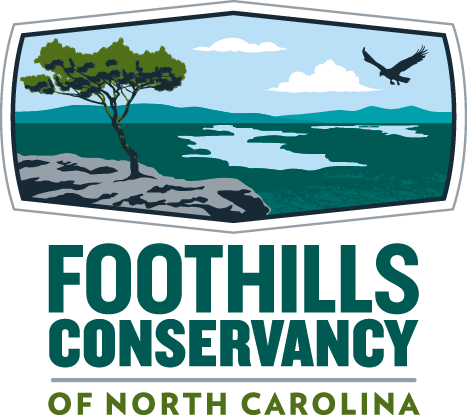Saving Hemlocks Organization Conducts Predator Beetle Release on Foothills Conservancy Property in Burke County
The Eastern hemlock trees on Foothills Conservancy’s Cane Brake property in Burke County are getting some special treatment courtesy of Saving Hemlocks, an organization based in Western North Carolina that promotes biological control of Hemlock woolly adelgids.Cane Brake, which is part of the conservancy’s Smith Cliff/Henry Fork River Preserve, recently became a stop on Saving Hemlocks founder Patrick Horan’s self-described “Johnny Beetleseed” campaign in which he travels the southern Appalachian Mountains in search of hemlock stands that are afflicted by the Hemlock woolly adelgid. He combats this invasive beetle by releasing predator beetles, Sasajiscymnus tsugae (also called Sasi), that feed on the Hemlock wooly adelgid.“We are fortunate to have a site with many large, mature Eastern hemlock trees that have not experienced the devastating effect of the Hemlock wooly adelgid, like most other hemlocks in our area,” said Foothills Conservancy’s conservation associate, Ryan Sparks. “By taking a proactive approach and releasing these predatory beetles before the Hemlock wooly adelgid has inflicted serious damage to the trees, we can maintain the health of these hemlocks and allow them to continue to flourish at this location.”The Hemlock woolly adelgid is a small, invasive insect, accidentally imported from Japan in the 1920s. The pest feeds off of stored starches in hemlock trees. Not only does it receive food from the tree, it remains in the same place for its entire life, disrupting the flow of nutrients to the trees needles and ultimately leading to the tree’s death within four to 10 years.Large-scale hemlock loss would be disastrous to Western North Carolina forests, waterways, neighborhoods, and parks. Hemlocks provide habitat for a range of animal species and, with no comparable species to replace it, the hemlock’s demise would threaten all ecosystems that depend on this tree.Horan has completed 10 years of predatory beetle releases, traveling hundreds of miles in North and South Carolina, Tennessee, Kentucky, and Georgia, as well as 60 miles of the Blue Ridge Parkway from Mount Pisgah to Cherokee, North Carolina. This is the third time Saving Hemlocks has done a predator beetle release on Foothills Conservancy properties.“My mission with Saving Hemlocks is applying the best, science-based information to biological control interventions against the Hemlock woolly adelgid,” said Horan. “I was pleased to help with the release at Cane Brake to protect and restore this hemlock cove ecosystem.”Scientific research has identified the Sasi predator beetle as the most effective and available biocontrol option for landowners with hemlocks. Rather than completely eliminate the adelgids, biocontrol establishes an ecological balance between predator and prey, allowing the existing adelgids to serve as a continued source of food for the Sasi predator beetles and to remain part of the ecosystem.Over three million Sasi predator beetles produced by USDA labs have been released in national and state parks, but most state and municipal hemlock areas and all private hemlock areas depend on private groups to implement biological control. Savings Hemlocks works with local land trusts and other nonprofit groups by purchasing Sasi predator beetles from a commercial rearing laboratory in Pennsylvania and donating and releasing the beetles to protect vital hemlock ecosystems.

